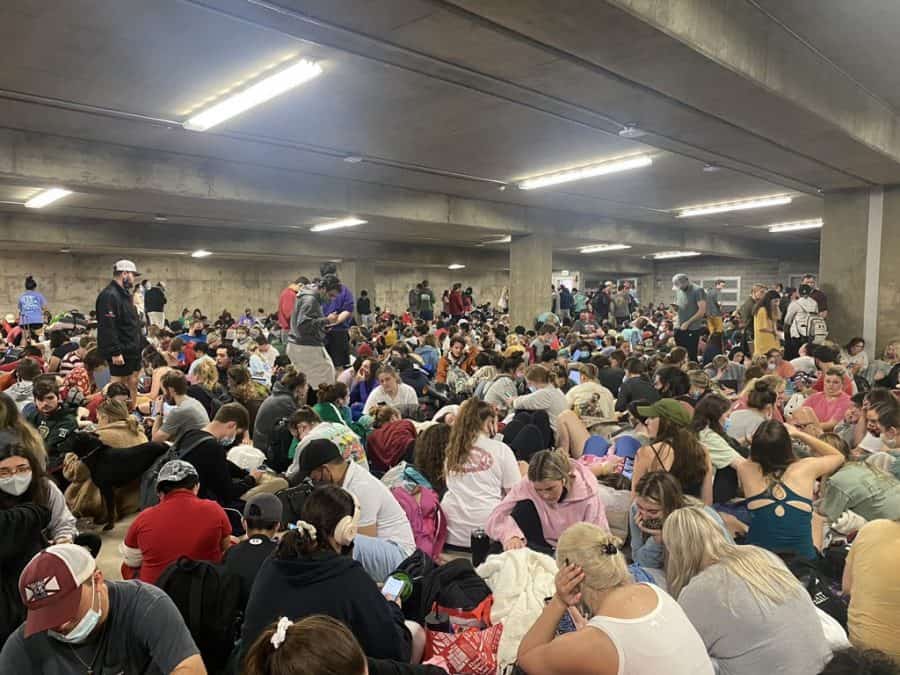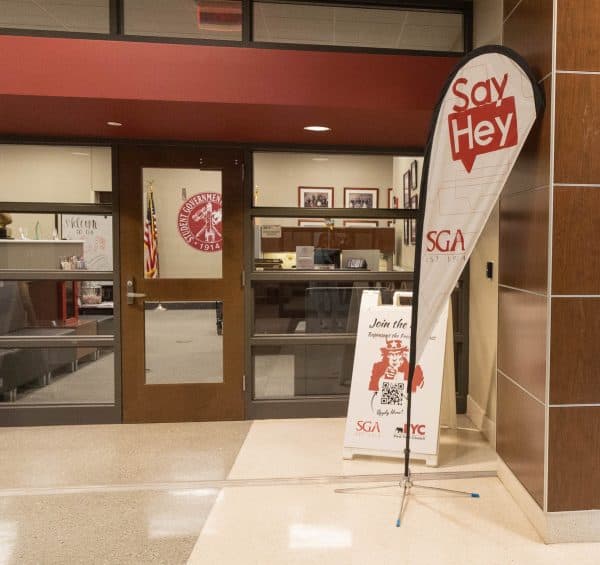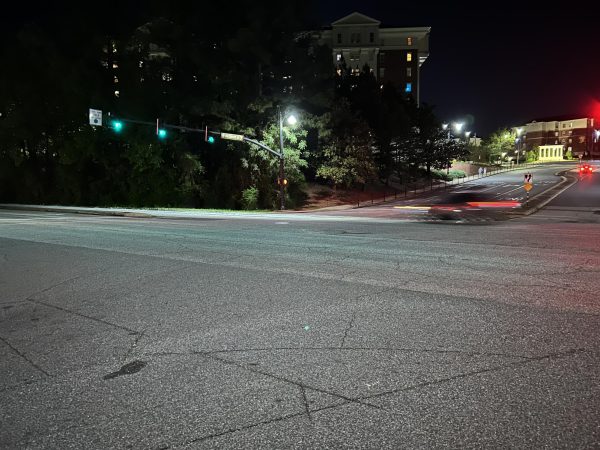‘Dixieland Delight’ and Few Masks in Sight: Reflections on sheltering at peak capacity
Here’s what we saw at three campus storm shelters
March 18, 2021
Faced with a long day of tornado watches and warnings, many students took advantage of the storm shelters on campus, protecting themselves from the risks of severe weather while accepting the potential health risks of sheltering in close quarters.
The University on Wednesday morning suspended normal operations after 11 a.m. because of the high risk of tornadoes and severe weather in the area. All classes, online and in-person, were canceled. Libraries, recreation centers and other campus facilities were closed through 5 a.m. on Thursday.
The seven storm shelters on campus opened at 10 a.m. and were available to students, faculty and staff, including those who live off campus. Coleman Coliseum was later opened as an additional shelter space.
In our own efforts to seek shelter, CW staff members found themselves at different storm shelters across campus. Here’s what we saw.
John England Jr. Hall – Keely Brewer, News Editor
I made it to the storm shelter in John England Jr. Hall around noon, a couple hours after the University suspended normal operations and opened on-campus shelters. A few dozen people were scattered across the room by then—well below its 1,600-person capacity.
While space remained available in all shelters across campus, UA Safety announced that the Ferg and Magnolia parking decks were at capacity. The Magnolia storm shelter is the only on-campus location designated as pet-friendly, but no pet owners were turned away at John England.
A UA official stopped by around 1:30 p.m. to take a headcount. There were 136 people in the shelter, and that number was fairly steady until the first tornado warning was issued an hour later.
Hundreds flooded in after the warning. One UA official spent the following hour trying to herd people together to make room for the dozens spilling into the hallway, all while one student sat at his desk and chair near the entrance, which he presumably brought with him.
Everyone was told to sit down and move closer to the walls to make room for people in the middle, but the buzz of sound made it impossible to hear her instructions.
To heighten the chaos in the room, one student turned on his speaker—an essential for any visit to the storm shelter—and played Dixieland Delight. In the mayhem of peak capacity at the John England storm shelter, one door facing Lakeside Dining Hall stayed open, to our confusion, as the tornado crossed McFarland.
Soon after, still in the midst of the tornado watch that was extended to 4:15 p.m., hundreds of people simultaneously stood up and left, including one boy with a fish bowl in tow. The shelter was back to fairly low occupancy for the rest of the night.
The scene in John England until a few minutes ago. Warning in place until 4:15 but people are flooding out. pic.twitter.com/UUtU0XgxTj
— keelykbrewer (@keelykbrewer) March 17, 2021
North Engineering Research Center – Zach Johnson, Assistant News Editor
The North Engineering Research Center remained only somewhat populated during the first wave of storms on Wednesday in the early afternoon. Plenty of space was available for more students.
Most left after the first two tornado warnings expired, though a few dozen remained into the evening hours. Only about half of students in attendance were masked, and UA employees with bright blue shirts monitored the shelters.
Students gathered in groups and played poker, wallball, and other games. Some students brought air mattresses, blankets, and pillows, while it seems others came only with what they had on.
Having been here since around 2:30 or so, the environment remained pretty calm. It’s 8:45 p.m. as I write this and a few students are returning to the shelter, though far fewer than were present earlier.
North Engineering Research Center – Alexander Plant, Sports Editor
I came in through the side door of the NERC at 3:15 and went down the stairs to the basement. There were no faculty or staff members present at the time.
I saw multiple people entering the building with masks, but once they got inside with their respective groups, most people took them off. Although the space had plenty of room, students congregated together to talk amongst each other and play games.
I was there until about 4:15 when the tornado warning was lifted, and what stood out to me was the patience that everyone had. I, however, watched James Spann non-stop until the storms had cleared. As soon as the tornado warning was lifted, I immediately walked out of the building to save myself from potentially contracting COVID-19.
Magnolia Parking Deck – Tessa Worley, Reporter
The Magnolia parking deck’s shelter was almost full within a few hours of the shelter opening. I chose this particular shelter because it is the only pet-friendly shelter on campus. One UA official in the shelter said the Magnolia parking deck was close to capacity and speculated that it could only hold 100 more people.
This official also said that they had not expected the large number of people and pets that arrived to seek shelter.
This shelter did not require dogs to be muzzled unless they were violent, and I didn’t see one used near me. Masks were also required and those who didn’t have one were provided one. When the first tornado warning was issued an official began to order people to move and make more room. This was difficult to do with so many dogs, cats and blanket camps. I hated having to pick up my stuff every time we had to move.
As time went on, the shelter continued to fill up quickly. Around 3:45 p.m., an official announced that he had received word that the University was no longer in danger and the shelter emptied quickly, even though the warning was in place until 4:15. A small number of people stayed through the evening.
After the national weather service issued a warning for Tuscaloosa more people pour into the already packed shelter at the Magnolia parking deck. pic.twitter.com/wuQmf3GTb6
— Tessa Worley (@TessaWorley2) March 17, 2021
Magnolia Parking Deck – Lexi Hall, Assistant Photo Editor
The shelter in Magnolia parking deck, the only pet-friendly designated shelter on campus was packed with dogs, cats and even a bunny rabbit.
Multiple times students kept having to get up and shift forward because the shelter was running out of space, which was frustrating because a lot of people had already set up camp.
It was very hot inside, people were dripping in sweat and when you looked around students had a look of worry on their face each time a new warning was issued.











